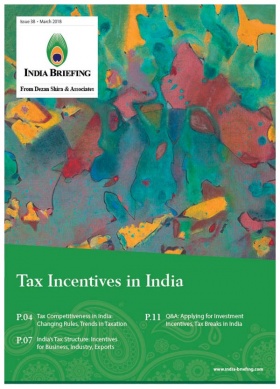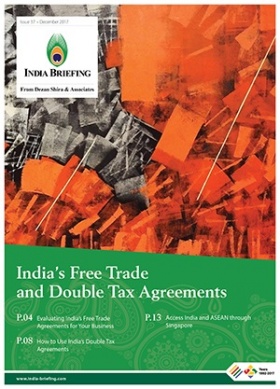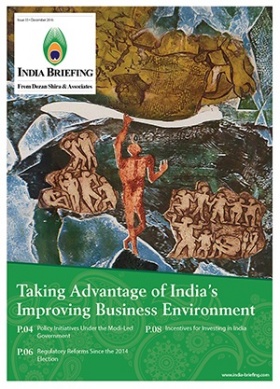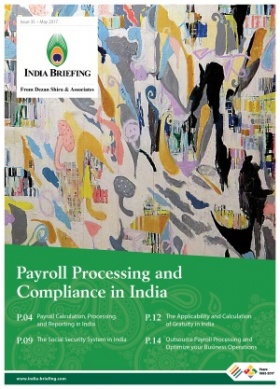India-South Asia FTAs and DTAAs
India’s trade and business relationship with its immediate South Asian neighbors is enjoying a period of revival, in large part due to the endorsement by the Modi government’s ‘Neighborhood First’ policy.
As China’s presence in South Asia continues to grow, India is taking proactive steps to maintain its own regional influence. This strengthening of cooperation includes rebuilding economic ties, improving regional connectivity as well as trade relaxations, tax breaks, and investment incentives.
 India-SAFTA: Key regional FTA
India-SAFTA: Key regional FTA
The South Asia Free Trade Area (SAFTA) encompasses Bangladesh, Bhutan, India, Maldives, Nepal, Pakistan, and Sri Lanka, and aims to stimulate regional trade by reducing tariffs on goods.
SAFTA’s goal to roll out favorable tariffs by 2015, has, however, met with protectionist government policies, diluting its effect. Each member country has a ‘sensitive list’ on goods that are exempt from tariff concessions. These sensitive lists remain long, though individual member countries have actively sought to reduce them over time.
In light of these regional challenges, India’s emphasis, in recent years, has begun to focus on improving its bilateral relationships. The role played by China is another motivator for India’s expanded economic agenda in the subcontinent, as trade and commerce ties are increasingly confronted by geopolitical developments.
Since 2014, the Indian government has announced several massive infrastructure projects in the northeastern border states. These projects will improve transport and logistics for traders and businesses in the region.
India-Bangladesh
Bangladesh borders five Indian states – West Bengal, Assam, Tripura, Mizoram, and Meghalaya. Both India and Bangladesh have significant coastlines along the Bay of Bengal. The Ganges and the Brahmaputra rivers, which originate in India, flow through Bangladesh and drain out into the Bay of Bengal.
The two countries are focused on leveraging their geographic advantages to optimize trading relationships. For instance, Bangladesh plays a key role in India’s sub-regional connectivity plans, which include the Bangladesh, Bhutan, India and Nepal (BBIN) Motor Vehicles Agreement (MVA).
Bilateral trade between India and Bangladesh accounted for US$7 billion in 2016-17. This crossed US$9 billion during the 2017-18 financial year (July-June in Bangladesh), when India’s imports amounted to close to US$900 million. Since July 2017, Bangladesh garment exports to India have jumped 113 percent, from US$129 million to US$276 million. Footwear, fish, and beverage imports from Bangladesh have also significantly increased.
The introduction of GST in 2017 led to the withdrawal of 12 percent countervailing duty (CVD) on textiles, which has allowed Bangladesh to enjoy greater benefits due to cost benefit advantages on 49 garment items. Even the recent hike of import duty on 328 textile products is not applicable to Bangladesh due to the absence of minimum value addition criteria in SAFTA.
The two countries have signed a bilateral trade agreement, which is renewed every five years.
India’s main exports to Bangladesh include:
- Food and processed items;
- Intermediate goods;
- Textiles;
- Small machinery; and,
- Consumer goods.
Under SAFTA, India provides Bangladesh with duty free access for all goods, except tobacco and alcohol. Bangladesh offers preferential tariffs to Indian traders, except for the 993 items on its sensitive list.
Apart from the trade agreement, the two countries have signed a number of agreements for enhancing regional connectivity and resource sharing. The Protocol on Inland Waterways Trade and Transit (PIWTT) was operationalized in 1972. It permits the movement of goods at eight specific points in the river system shared between India and Bangladesh.
Finally, the Coastal Shipping Agreement, signed in 2015, enables direct sea movement of cargo between ports in the two countries, reducing shipping times from 40 days to just 5 days.
India-Bhutan
Bhutan is a tiny Himalayan kingdom that shares a border with five Indian states – Assam, Arunachal Pradesh, West Bengal, and Sikkim.
The two countries have enjoyed a free trade regime since 2006, which was renewed again in 2017. Through the India-Bhutan Trade and Transit Agreement, India allows duty free transit of Bhutanese goods to third countries.
However, Bhutan does not allow tariff concessions for about 150 items on its sensitive list under SAFTA.
India imports about 82 percent of Bhutan’s total exports. Electricity constitutes one-third of Bhutan’s exports to India. Bhutan also exports minerals such as ferro-silica, cement, and dolomite.
India-Nepal
Nepal is a small Himalayan country near India’s eastern border. The India-Nepal Treaty of Peace and Friendship of 1950 has defined bilateral relations between the two countries – loosening borders and enhancing opportunities for Nepalis in India.
The volume of bilateral trade between India and Nepal hit nearly US$6 billion in 2016-17.
India’s main exports to Nepal include:
- Petroleum products;
- Motor vehicles and spare parts;
- Paddy;
- Machinery and spare parts;
- Medicine;
- Electrical equipment;
- Cement; and,
- Agricultural equipment.
Nepal’s main exports to India include:
- Fruit concentrate;
- Oil cakes;
- Jute goods;
- Handicrafts;
- Noodles;
- Wool; and,
- Spices.
The India-Nepal Treaty of Trade and Agreement of Co-operation to Control Unauthorized Trade, 2009 is the bilateral framework regulating the two nations’ cross-border trade.
The Treaty enables mutual duty free access to primary products such as wheat, bran, husk, bristles, herbs, stone aggregates, boulders, sand, and gravel. Products manufactured in Nepal enjoy access to the Indian market; Nepal’s small enterprises enjoy similar benefits as Indian SME products. Under SAFTA, Nepal does not allow tariff concessions for about 1,295 items on its sensitive list.
India and Nepal have also made advances in the power sector. The two countries signed a Power Trade Agreement (PTA) in 2014 with the aim of strengthening cross-border electricity transmission, grid connectivity, and power trade.
India-Pakistan
Pakistan borders four Indian states – Jammu and Kashmir, Punjab, Rajasthan, and Gujarat. India and Pakistan are the two largest and most populous nations in South Asia. However, political relations between the two nations have been fraught since the very creation of the two nations. Since 1947, India and Pakistan have had four wars while hostile border confrontations remain a regular phenomenon.
Despite these challenges, Indo-Pakistan bilateral trade continues, and stood at US$2.28 billion in 2017. India’s major exports to Pakistan include:
- Cotton;
- Organic chemicals;
- Machinery,
- Animal fodder;
- Vegetables;
- Plastic articles;
- Coffee, tea and spices;
- Dyes; and,
- Oil seeds.
Pakistan’s major exports include:
- Copper;
- Fruits and nuts;
- Cotton;
- Salt;
- Sulfur;
- Earths and stones;
- Organic chemicals;
- Mineral fuels;
- Rubber plastic products; and,
- Wool.
India has given Pakistan ‘Most Favored Nation’ (MFN) status, a provision under the World Trade Organization (WTO) that calls for mutually beneficial trade relations. There is no formal bilateral trade agreement between the two countries, although India extends tariff cuts to Pakistan’s traders under SAFTA. The Customs Cooperation Agreement, Mutual Recognition Agreement and Redressal of Trade Grievances Agreement, signed in 2012, governs trade related regulations, tariffs, and barriers between the two countries.
Trade between the two countries occurs primarily on land. A Joint Business Forum (JBF) held its first meeting in 2013. The JBF focuses on promoting trade in agriculture, pharmaceuticals, automobiles, and healthcare. Under SAFTA, Pakistan does not allow tariff concessions for 936 items on its sensitive list.
India-Sri Lanka
Sri Lanka is an island nation in the Indian Ocean. It lies to the south of mainland India, and the two countries are separated by the Palk Strait.
India is one of Sri Lanka’s biggest trading partners. In 2016-17, bilateral trade between the two countries stood at US$4.65 billion.
The India-Sri Lanka Free Trade Agreement came into effect in March 2000. However, while Sri Lankan exports to India have greatly benefited from the FTA (by about 70 percent), Indian imports remain mostly outside the agreement. Further, under SAFTA, Sri Lanka does not allow tariff concessions for about 1,042 items on its sensitive list.
Indian exports to Sri Lanka include:
- Aircraft and spacecraft parts;
- Vehicles;
- Auto components and accessories;
- Mineral oils and products;
- Shipping machinery;
- Cotton;
- Pharmaceutical products;
- Machinery and mechanical appliances;
- Chemicals;
- Cement; and,
- Electrical machinery.
Sri Lankan exports to India include:
- Nuts;
- Spices;
- Animal feed;
- Ship and boat vessels;
- Apparel;
- Processed food and beverage;
- Rubber; and,
- Glass work.
 Market opportunities expanding in South Asia
Market opportunities expanding in South Asia
Despite Chinese investments in the region, India remains a leading actor in South Asia given its historic trading routes and sociocultural ties with neighboring countries. As Bradley Dunseith, International Business Advisory, Dezan Shira & Associates writes, “India’s focus on developing its infrastructure for both domestic manufacturing and cross-border transportation is also likely to benefit foreign invested companies in the region as it opens up new market opportunities”.
As South Asia’s logistics and cross-border bureaucracy continues to improve, investors should consider incorporating emerging South Asian markets into their India strategies.
Editor’s Note: The article includes an update on India and Bangladesh bilateral trade on August 16, 2018.
About Us
India Briefing is published by Asia Briefing, a subsidiary of Dezan Shira & Associates. We produce material for foreign investors throughout Eurasia, including ASEAN, China, Indonesia, Russia, the Silk Road, & Vietnam. For editorial matters please contact us here and for a complimentary subscription to our products, please click here.
Dezan Shira & Associates provide business intelligence, due diligence, legal, tax and advisory services throughout India and the Asian region. We maintain offices in Delhi and Mumbai and throughout China, South-East Asia, India, and Russia. For assistance with India investment issues or into Asia overall, please contact us at india@dezshira.com or visit us at www.dezshira.com.
- Previous Article Les chaînes d’approvisionnement en Inde : à l’aube d’une révolution
- Next Article Indiens E-Commerce-Markt im Wachstum


















